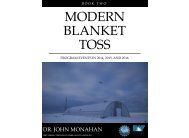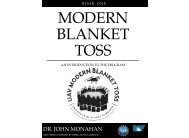Modern Blanket Toss: Findings and Observations
This book is the last in a series of three covering the National Science Foundation awarded Modern Blanket Toss project. In this book are the evaluation findings for each of the three years as well as observations from Modern Blanket Toss staff.
This book is the last in a series of three covering the National Science Foundation awarded Modern Blanket Toss project. In this book are the evaluation findings for each of the three years as well as observations from Modern Blanket Toss staff.
You also want an ePaper? Increase the reach of your titles
YUMPU automatically turns print PDFs into web optimized ePapers that Google loves.
2016 FINDINGS<br />
The mission of <strong>Modern</strong> <strong>Blanket</strong> <strong>Toss</strong> was to help these Upward Bound students<br />
develop interest in STEM fields through the use of technology that can directly<br />
improve the well-being of Alaskans. The project’s goal was to demonstrate how<br />
a three-part program of science education built around 1) cutting-edge STEM<br />
technologies (in this case, UAVs), 2) science communication <strong>and</strong> leadership skills,<br />
<strong>and</strong> 3) community involvement, can better expose these students to STEM<br />
careers, prepare them for higher education, <strong>and</strong> enable them to contribute to<br />
their communities.<br />
Seven Upward Bound programs participated in <strong>Modern</strong> <strong>Blanket</strong> <strong>Toss</strong> over the<br />
three year program period: Chefornak, Seward, Bethel, Nikiski, Shishmaref,<br />
Chevak, <strong>and</strong> Saint Mary’s. These communities vary widely in terms of location,<br />
local economy, population size, poverty levels, racial makeup, <strong>and</strong> income,<br />
representing a cross-section of rural Alaska. Overall, 28 individual students<br />
attended at least one summer session of the <strong>Modern</strong> <strong>Blanket</strong> <strong>Toss</strong> program – 19<br />
students attended one summer session, six students attended two summer<br />
sessions, <strong>and</strong> three students attended three summer sessions. Approximately 60<br />
individual students participated in the <strong>Modern</strong> <strong>Blanket</strong> <strong>Toss</strong> activities at their<br />
Upward Bound site.<br />
The purpose of the evaluation was to assess the effectiveness<br />
of the <strong>Modern</strong> <strong>Blanket</strong> <strong>Toss</strong> program in increasing the<br />
likelihood that participating students would go on to pursue<br />
college degrees in STEM areas <strong>and</strong> ultimately pursue STEM<br />
careers. The evaluation used six indicators to measure the<br />
program’s effectiveness, including 1) Upward Bound local<br />
coordinator capacity to facilitate the program locally; 2)<br />
student satisfaction <strong>and</strong> engagement with program activities;<br />
3) student knowledge about the <strong>Modern</strong> <strong>Blanket</strong> <strong>Toss</strong><br />
content; 4) student communication <strong>and</strong> leadership skills; 5)<br />
student interest in STEM <strong>and</strong> confidence in STEM abilities;<br />
<strong>and</strong> 6) student academic data including their overall grade<br />
point average <strong>and</strong> their math <strong>and</strong> science course grades<br />
specifically.<br />
Key <strong>Findings</strong><br />
At the beginning of the project, Upward Bound local coordinators reported<br />
already feeling they had the knowledge <strong>and</strong> ability to implement science<br />
practices <strong>and</strong> project-based learning with their students, yet by the end of the<br />
three year project they reported significant gains in their knowledge about<br />
UAVs <strong>and</strong> GIS software instrumental in planning <strong>and</strong> carrying out community<br />
projects.<br />
• Local coordinators made the greatest gains in four areas: how to build a UAV,<br />
applications of UAV technology, the safety rules <strong>and</strong> regulations that apply to<br />
flying a UAV, <strong>and</strong> how to acquire different types of data using UAVs.<br />
• Three areas showed no gains, because coordinators reported high levels of<br />
knowledge at the beginning of the program: The range of science, technology,<br />
engineering <strong>and</strong> math careers that are available to students; the level of math<br />
<strong>and</strong> science students will need for various science, technology, engineering, <strong>and</strong><br />
math careers; <strong>and</strong> principles of flight (e.g., lift, drag, gravity).<br />
• Coordinators reported a low level of initial knowledge <strong>and</strong> little growth<br />
related to several important content areas that were potentially important to<br />
community projects: how to ask questions using GIS software; how to use GIS<br />
mapping software; <strong>and</strong> how to acquire data from databases.<br />
• Students reported consistently high satisfaction with the <strong>Modern</strong> <strong>Blanket</strong><br />
<strong>Toss</strong> summer program. In particular students noted the following:<br />
• Students were excited about learning new technology.<br />
• Students liked the h<strong>and</strong>s-on aspect of the course, both the experience flying<br />
<strong>and</strong> the application of mapping.<br />
• Students felt that the connections they made with people was an important<br />
benefit of the program <strong>and</strong> appreciated working together with like-minded<br />
peers, <strong>and</strong> cited this as an important aspect of the program.<br />
35




